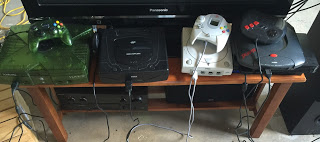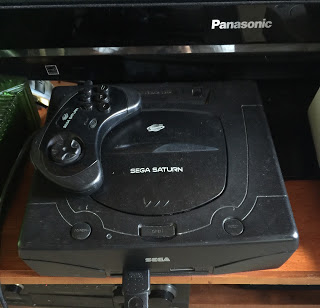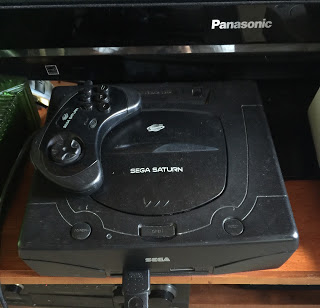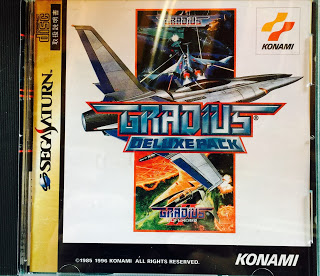In a way though the Saturn is also one of the systems with a legacy of failure hot on its heels. It was after all a commercial failure in North America, having been poorly marketed on its own, and part of Sega’s mixed signals to consumers with the launch of the 32x and Sega-CD add-ons for the Genesis before the Saturn ever made it here. Today one can point out Sega’s use of price-point marketing in order to give consumers various ways of owning their systems based on budget, but in the mid-90’s such marketing techniques where and in many ways still are foreign to the video game manufacturing and marketing world. What was even more detrimental to the Saturn though was it’s sudden and nearly surprise release in North America, which left many retailers unprepared, and many consumers unaware of the systems release. With retailers unprepared for the systems launch many retailers never had time to hammer out purchase agreements with Sega, meaning many opted not to carry the product at all. Although it’s debated why Sega would engage in such a tactic, many believe it was a decision made in panic in order to beat Sony’s PlayStation into stores. History now shows us the folly of this decision.
Another interesting aspect of the Saturn, is actually the story of its development and its perceived competition at the time. Based on the SNES vs Genesis console wars of the 4th generation, the Saturn wasn’t actually developed to be the N64’s head competitor in Gen 5 consoles. Although it seems somewhat odd to think about, Sega built the Saturn to directly compete with the Atari Jaguar, which based on performance and spec’s was projected to be Gen 5’s biggest system. Although Sega knew it would have to go up against its old foe Nintendo, many in the world of consumer electronics saw the N64 as a bit of an under-powered and outdated joke that wouldn’t be a serious competitor in the next generation of consoles. In many ways the N64, although still a classic, was under-powered compared to its competition, and slightly outdated bringing cartridges to a CD-ROM fight, since even the Jaguar had a CD add-on lined up by thay time. For Sega much like Nintendo, the big winner of generation 5, the Sony PlayStation, actually came completely out of left field, although many would argue it was a monster of Nintendo’s own making.

The Saturn two doors down from its projected rival the Atari Jaguar. Its other neighbors the PS2, Dreamcast, and XBOX hail from the following generation of systems
The Saturn, despite it’s last minute release and abysmal sales figures, was actually a fairly good system. Like CD based systems of the time it does lag here and there on it’s load times, but what it produces graphically is on par with the PlayStation, part of the reason their where many titles the two systems shared, just as the PS4 and XB1 do now. Like all Gen 5 systems some games do have those jagged angles common for early polygonal games, but the higher the quality of the game the less you see of that. For instance EA’s Soviet Strike is a beautifully rendered game on the Saturn devoid of the jagged angles, and looks equally good on the PS1. What I like about the Saturn is that Sega, despite shooting itself in the head at release time, produced a truly excellent system that should have gone head to head with the PlayStation and left Gen 5 as a co-champion or slightly behind. For all intents and purposes the Saturn was very much an equal to the PS1 and its easy to see that just by playing games the two systems shared.
My Likes:
The Saturn definitely has an evolutionary feel to it, especially when it sits very near by the Genesis and Dreamcast in my play area. It’s nice to have this system which isn’t some crazy add-on, but rather a fully thought-out free standing system that truly feels as if it has moved on from its Genesis roots. The console itself is somewhat larger than a Mk1 – PS1, and also has a nice weight to it. It’s color is a bland gray, but that’s forgivable since its not always how it looks but how it plays, even though its grandfather the Master System looked like an F-117A. The controller is typical and similar to that of the Genesis, perhaps slightly more boomerang looking, but still black and lightweight. In appearance compared to a PS1, the Saturn looks like a tank, and even the CD door seems hunkered down, but whats truly odd is the cartridge slot behind that (which I will get into later). Overall, the controller works well on this system, and for a Gen 5 system the load times aren’t really all that bad. It hooks up easy as well with a standard y/r/w RCA cable, and regular sized wall plug-in, which was all common by that era.
As far as how the games look and play, I can tell you that I really haven’t seen any signs of slow down or CD loading mid-game, as far as sound its also very good what I would call near CD quality on par with the PS1. The games tend to look as good as games of that generation normally do, and in some cases as previously mentioned it depends on the game itself, but again the Saturn is on par with what I’ve seen on my PS1. As far as the hardware, when it come to consoles that’s not something I get into unless it under-performs, which this system doesn’t.
My Dislikes:
First of all since Sega botched the launch of the Saturn so badly, there is a major issue with many of the Saturn’s best games only being released in Japan.
Gradius: Deluxe Pack for example, considered to be one of the best SHMUP’s on the system, is actually a title I had to import. Although the North American product line is good, and continually surprises me, I still find it upsetting that some of the best games never got released here. Of course as long as we are on this subject, let me go back to that cartridge slot behind the CD door I just mentioned. This slot isn’t for backward compatibility with old Sega carts, but rather is for a RAM expansion module. You see my above Gradius: Deluxe Pack CD-ROM, currently can’t operate on my Saturn until I get one of these carts. Apparently, the North American Saturn is under-power compared to it’s Japanese counterpart.
Although a bit peeved and unimpressed by the small North America library, and the RAM issue I still will tell you that the Saturn is a nice system. As a Sega fan and/or collector the Saturn is an important link in Sega’s history and decline following the Genesis, and before it’s beloved swan song the Dreamcast. The system does tend to command a slightly higher price than other similar systems like the N64 and PS1, but is no where near as pricey as a Neo Geo AES, or an Amiga CD32, so you should be able to pick one up for under a $100 out of box and with the basics of eBay.


